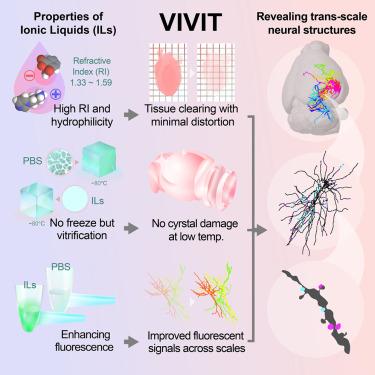VIVIT: Resolving trans-scale volumetric biological architectures via ionic glassy tissue
IF 42.5
1区 生物学
Q1 BIOCHEMISTRY & MOLECULAR BIOLOGY
引用次数: 0
Abstract
Biological structures across scales integrate seamlessly to perform essential functions. While various histological methods have been developed to reveal these intricate structures, preserving the integrity of large-volume architectures while revealing microstructures with high resolution remains a major challenge. Here, we introduce vitreous ionic-liquid-solvent-based volumetric inspection of trans-scale biostructure (VIVIT), a 3D histological method leveraging the chemical properties of ionic liquids. VIVIT transforms biological tissue into an ionic glassy state, which enables optical clearing with minimal distortion and high transparency, preserves tissue from low-temperature crystal damage, and amplifies fluorescent signals from both genetically encoded and immunostained labels, thus yielding precise and reliable mapping of fluorescent signals within intact 3D architectures. Using VIVIT, we demonstrate the link between the modality of synaptic inputs to multisensory thalamic neurons and the targets of their brain-wide outputs and identified aspects of inhibitory control in the human cortex. VIVIT thus offers opportunities to elucidate the organizational principles underlying trans-scale biostructures.

VIVIT:通过离子玻璃组织解析跨尺度体积生物结构
跨尺度的生物结构无缝集成以执行基本功能。虽然已经开发了各种组织学方法来揭示这些复杂的结构,但在高分辨率揭示微观结构的同时保持大体积结构的完整性仍然是一个主要挑战。在这里,我们介绍了基于玻璃离子-液体-溶剂的跨尺度生物结构体积检测(VIVIT),这是一种利用离子液体化学性质的三维组织学方法。VIVIT将生物组织转化为离子玻璃态,从而实现最小畸变和高透明度的光学清除,保护组织免受低温晶体损伤,并放大来自遗传编码和免疫染色标记的荧光信号,从而在完整的3D结构中产生精确可靠的荧光信号映射。使用VIVIT,我们证明了突触输入到多感觉丘脑神经元的方式与它们的全脑输出目标之间的联系,并确定了人类皮层中抑制控制的各个方面。因此,VIVIT为阐明跨尺度生物结构的组织原理提供了机会。
本文章由计算机程序翻译,如有差异,请以英文原文为准。
求助全文
约1分钟内获得全文
求助全文
来源期刊

Cell
生物-生化与分子生物学
CiteScore
110.00
自引率
0.80%
发文量
396
审稿时长
2 months
期刊介绍:
Cells is an international, peer-reviewed, open access journal that focuses on cell biology, molecular biology, and biophysics. It is affiliated with several societies, including the Spanish Society for Biochemistry and Molecular Biology (SEBBM), Nordic Autophagy Society (NAS), Spanish Society of Hematology and Hemotherapy (SEHH), and Society for Regenerative Medicine (Russian Federation) (RPO).
The journal publishes research findings of significant importance in various areas of experimental biology, such as cell biology, molecular biology, neuroscience, immunology, virology, microbiology, cancer, human genetics, systems biology, signaling, and disease mechanisms and therapeutics. The primary criterion for considering papers is whether the results contribute to significant conceptual advances or raise thought-provoking questions and hypotheses related to interesting and important biological inquiries.
In addition to primary research articles presented in four formats, Cells also features review and opinion articles in its "leading edge" section, discussing recent research advancements and topics of interest to its wide readership.
 求助内容:
求助内容: 应助结果提醒方式:
应助结果提醒方式:


